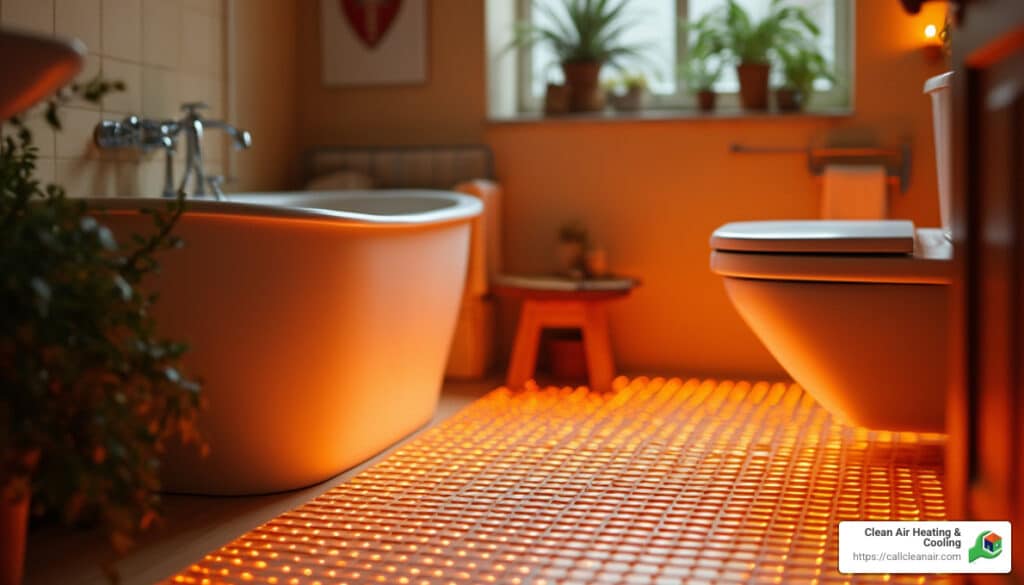Heated bathroom floors have rapidly become a popular choice for homeowners seeking comfort and luxury. These innovative floors offer warmth during chilly mornings and create a soothing environment, making them more than just a luxury—they’re an investment in your home. They provide:
- Consistent warmth ensuring a cozy and inviting feel every time.
- Even heating across the entire bathroom floor.
- Energy efficiency, designed to keep costs manageable.
Heated floors eliminate the shock of stepping onto a cold floor, making your daily routine more pleasant. Their space-saving feature means no clunky radiators, allowing for a sleek, modern look in your bathroom.
As Colin Matei, I’ve worked extensively in providing state-of-the-art HVAC solutions, focusing on heated bathroom floors in Northwest Washington. My experience ensures that you’ll receive expert advice custom to your home’s unique needs.

Benefits of Heated Bathroom Floors
Heated bathroom floors are more than just a luxury. They’re a smart choice for enhancing comfort, boosting energy efficiency, and increasing home value.
Comfort
Imagine stepping out of the shower onto a floor that’s warm and inviting. Heated floors offer consistent warmth, changing cold, unwelcoming tiles into a cozy oasis. No more shivering on chilly mornings! The even distribution of heat means no cold spots, ensuring your entire bathroom is a haven of comfort.
Energy Efficiency
Heated floors are not only comfortable but also energy efficient. Unlike traditional heating systems that heat the air, radiant floor heating warms the room from the ground up. This method is efficient because it reduces the need for additional heating sources, keeping energy costs manageable.

Moreover, using programmable thermostats allows you to control the temperature, optimizing energy usage. You can set the floors to heat up only when needed, helping to lower electricity costs over time.
Home Value
Investing in heated bathroom floors can significantly improve your home’s value. Real estate professionals note that radiant heating is a sought-after feature. Sarah Johnson, a real estate agent, mentions, “Beyond energy efficiency and comfort, radiant heating can also increase the value of your home. It’s a sought-after feature in the real estate market, appealing to a wide range of buyers.”
Including heated floors in your bathroom can make your property stand out in a competitive market. Buyers appreciate the added comfort and modern touch, potentially leading to increased interest and a higher selling price.

Incorporating heated bathroom floors is a strategic move for homeowners looking to improve their living space while also considering long-term benefits like energy savings and increased property value.
Let’s explore the cost considerations for installing these luxurious yet practical floors.
Cost Considerations for Heated Bathroom Floors
When considering heated bathroom floors, it’s important to weigh the costs involved. These costs can be broken down into three main categories: installation, energy, and the size of your bathroom.
Installation Costs
Installing heated floors involves both flooring and electrical work. The type of flooring you choose can significantly impact the cost. Ceramic tiles and natural stone are popular choices because they conduct heat well. However, they can be more labor-intensive to install, potentially increasing costs.
The electrical installation is another factor. Connecting the heating system to your home’s power supply and installing a thermostat should be done by a licensed electrician. Although this adds to the initial cost, professional installation ensures safety and efficiency.
Energy Costs
One of the key advantages of heated bathroom floors is their energy efficiency. Radiant heating warms the room from the ground up, which can be more efficient than traditional heating systems. Using a programmable thermostat allows you to control when the floors are heated, optimizing energy usage and reducing electricity costs over time.
Bathroom Size
The size of your bathroom will directly affect installation and energy costs. Larger bathrooms require more heating elements and materials, which can increase both the installation and operational costs. Conversely, smaller bathrooms are less expensive to heat and install.
Choosing spot heating instead of full coverage is a cost-effective alternative. This involves heating only high-traffic areas, such as in front of the vanity or shower, reducing both material and energy costs while still providing warmth where it’s most needed.
In summary, while the upfront cost of installing heated bathroom floors may seem significant, the long-term benefits—such as energy savings and increased home value—often justify the investment. Next, we’ll explore the installation process for these luxurious floors.
Installation Process
Installing heated bathroom floors can transform your morning routine into a cozy experience. Let’s explore how this works, focusing on electric underfloor heating, the steps involved, and the best flooring materials to use.
Electric Underfloor Heating
Electric underfloor heating is popular for bathrooms because it’s efficient and easy to control. It consists of electric wires or mats installed under the floor. When connected to a thermostat, you can easily manage the floor’s temperature, ensuring warmth whenever you need it.
Installation Steps
- Prepare the Subfloor
Start by removing any existing flooring. Ensure the subfloor is clean, dry, and level. This step is crucial for effective heat distribution and to prevent future issues. - Install Insulation
Although optional, adding insulation boards can improve heating efficiency by preventing heat loss downward. This step is highly recommended for maximizing energy savings. - Lay Out Heating Elements
Depending on your choice, you can use either heating mats or loose cables. - Heating Mats: Roll them out over the subfloor, cutting the mesh (not the wires) to fit the space around fixtures.
- Loose Cables: Manually route cables, maintaining even spacing for uniform heat distribution.
- Connect to Electrical Supply
Connect the heating system to your home’s electrical system. This step should be done by a licensed electrician to ensure safety and compliance with electrical codes. - Install Flooring
Once the heating elements are in place, install your chosen flooring. Popular options include ceramic tiles and natural stone, which are excellent at conducting heat. Be careful not to damage the heating elements during this step. - Test the System
Before using your heated floor, test the system to ensure everything is working correctly. This involves checking the resistance of the heating elements with a digital ohmmeter.
Flooring Materials
Selecting the right flooring material is vital for both aesthetics and functionality. Here are some top choices:
- Ceramic Tiles: Durable and excellent at conducting heat, ceramic tiles come in various colors and patterns, allowing for a customized look.
- Natural Stone: Options like marble or granite not only look luxurious but also retain heat well, keeping your bathroom toasty.
- Vinyl and Linoleum: These resilient materials are comfortable underfoot and work well with heated floors, offering a wide range of styles and colors.
By following these steps and selecting the right materials, installing heated bathroom floors becomes a manageable project that adds comfort and value to your home. Now, let’s explore how these floors impact energy usage.
Heated Bathroom Floors and Energy Usage
Heated bathroom floors aren’t just about comfort—they’re also an energy-efficient choice. Let’s explore how these floors help you save on electricity costs, especially when paired with modern technology like programmable thermostats.
Energy Efficiency
One of the standout features of heated bathroom floors is their ability to provide consistent warmth without the need for high temperatures. Unlike traditional heating systems that heat the air, radiant floor heating warms the objects and people in the room directly. This method is more efficient because it reduces heat loss and maintains a steady temperature.
Programmable Thermostats
Using a programmable thermostat with your heated floors can significantly improve energy efficiency. These thermostats allow you to set specific times for the floor to heat up, ensuring it’s warm when you need it and conserving energy when you don’t. For instance, you can schedule the floors to warm up just before you wake up in the morning or before you return home in the evening.
- Smart Thermostats: Some advanced models, like the Warmup 6iE Smart WiFi Thermostat, can be controlled via smartphone apps. This gives you the flexibility to adjust settings remotely, further optimizing energy usage and comfort.
Electricity Costs
While the initial cost of installing heated bathroom floors might seem steep, the long-term savings on electricity can offset this. Radiant heating systems often operate at lower temperatures compared to forced-air systems, which means they use less energy. Additionally, because they distribute heat evenly, you can set the thermostat lower than you would with traditional systems and still feel warm.
Here’s a quick comparison:
| Heating System | Typical Operating Temperature | Energy Efficiency |
|---|---|---|
| Radiant Floor Heating | Lower temperatures | High |
| Forced-Air Heating | Higher temperatures | Moderate |
By investing in heated bathroom floors and utilizing a programmable thermostat, you can enjoy a cozy bathroom while keeping your electricity bills in check. Next, let’s tackle some frequently asked questions about these innovative floors.
Frequently Asked Questions about Heated Bathroom Floors
Are heated floors in the bathroom worth it?
Absolutely! Heated bathroom floors are a luxury that offers more than just comfort. Imagine stepping out of a hot shower onto a warm floor instead of cold tiles—it’s a small pleasure that makes a big difference. Besides comfort, these floors can boost your home’s value. Real estate agents often highlight radiant heating as a desirable feature, appealing to potential buyers who value modern, energy-efficient upgrades. With the combination of comfort and increased home value, heated bathroom floors are a worthwhile investment.
How much does it cost to put a heated floor in a bathroom?
The cost of installing heated bathroom floors can vary based on several factors. The size of your bathroom, the type of heating system, and the materials you choose all play a role. Generally, electric radiant floor heating systems are popular for bathrooms due to their ease of installation and efficiency in smaller spaces. While the initial costs might seem high, they include the heating mats or cables, a thermostat, and necessary accessories. It’s important to consider these costs as an investment in comfort and energy savings over the long term.
Do heated bathroom floors use a lot of electricity?
Not necessarily. One of the advantages of heated bathroom floors is their energy efficiency. These systems operate at lower temperatures than traditional heating methods, which helps in reducing electricity usage. By warming the floor directly and distributing heat evenly, you can keep the thermostat at a lower setting and still feel warm. Using a programmable thermostat can further optimize energy use by allowing you to control when the floors heat up, ensuring they only use electricity when needed. This efficient use of energy means that, over time, the electricity costs can be quite manageable, making heated floors both a comfortable and cost-effective choice.
By addressing these common questions, we hope to have shed some light on the practical and financial aspects of heated bathroom floors. Now, let’s explore how these floors are installed and what materials work best.
Conclusion
At Clean Air Heating & Cooling, we understand that comfort and satisfaction are key when it comes to your home. That’s why we offer top-notch installation services for heated bathroom floors. Our team is dedicated to providing a cozy and luxurious experience from the ground up. Imagine the delight of stepping onto a warm floor every morning—it’s a simple pleasure that can make a big difference in your daily routine.
Customer satisfaction is at the heart of what we do. With over 480 5-star reviews, our clients in Northwest Washington trust us to deliver prompt and high-quality service. We guarantee a 25% utility savings, ensuring that your investment in heated floors not only improves your comfort but also contributes to energy efficiency.
By choosing us, you’re not just investing in a product—you’re investing in a service that prioritizes your needs and comfort. Our expertise in radiant floor heating ensures a seamless installation process, custom to your specific requirements. We’re committed to making your home a warm and welcoming space.
For more information on our radiant floor heating services and to see how we can help you step into comfort, visit our service page. Experience the difference with Clean Air Heating & Cooling, where your satisfaction is our top priority.





